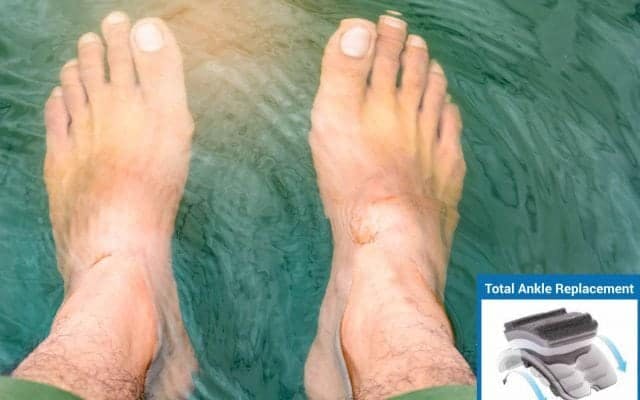- Blog
Total Ankle Replacement FAQs
Posted on 12-30-2025 in Ankle Pain & Total Ankle Replacement by Dr. Erik Nilssen

Posted on 12-30-2025 in Ankle Pain & Total Ankle Replacement by Dr. Erik Nilssen
IS TOTAL ANKLE ARTHROPLASTY (TAA) A GOOD OPTION FOR ANYONE WITH ANKLE ARTHRITIS?
While TAA can be a very good solution for many patients with advanced ankle arthritis, it’s not always the best solution. In general, TAA may not be a good choice for patients with:
• prior ankle joint fusion surgery
• active local or systemic infections
• certain types of nerve problems called neuropathy or other neurological problems
• insufficient bone or muscle tissue that interferes with proper positioning and stabilization of the implant
• problems with the ligaments that support the ankle
• some circulation issues, including vascular necrosis in the region
• issues affecting the skin or soft tissues surrounding the joint, which could interfere with normal healing
• certain anatomical deformities in the ankle area or in the knee that preclude proper positioning of the joint replacement
• inability to follow through with postoperative instructions, including physical therapy
WHAT TO EXPECT
If you’re overweight, you may be asked to lose weight prior to surgery to reduce the stress on the implant once it’s in place. Patients who smoke will need to stop two weeks before surgery to improve circulation, which is necessary for proper healing.
Total ankle arthroplasty is performed under general anesthesia. The specific surgical technique will depend on the implant that’s being used. Our practice uses the Salto® Total Ankle Prosthesis & the Zimmer Biomet Trabecular Metal Total Ankle; these are state-of-the-art ankle implants designed to more accurately replicate normal ankle anatomy for optimized function and mobility and natural joint movement. The procedure begins with an incision on the front and top of the ankle joint to provide total access to the joint. Once the joint is exposed, a special alignment guide is placed on the tibia (the lower leg bone that makes up part of the ankle joint) to ensure the implant is properly placed. The Zimmer© Biomet Trabecular Metal™ Total Ankle amount of the tibia bone is removed, followed by removal of a portion of the talus bone (one of the bones of the foot that comprises part of the ankle joint). Bone tissue is removed from three areas of the talus to provide greater stability for the implant.
Next, the implants are temporarily positioned over the bones, and the surgeon carefully assesses the joint function and movement, adjusting the placement of the implant components as needed. Once the surgeon has determined the ideal placement of the implant, the implant components are permanently placed on the bones, and the incisions are closed with small sutures (stitches). A splint or cast will be placed on the foot to keep the ankle stable and protected. Most patients remain in the hospital for a day or two before being discharged.
Check out this video: The Zimmer© Biomet Trabecular Metal™ Total Ankle.
AFTER ANKLE JOINT REPLACEMENT: RECOVERY AND LIFESTYLE CHANGES
Once your surgery is complete, it’s very important to closely follow your surgeon’s guidelines during recovery to ensure the area around the implant heals properly. A cast will be applied to the ankle, and you’ll need to use crutches, a walker, or a wheelchair to avoid any weight bearing on the joint for four to six weeks after surgery. A moderate amount of pain is normal during the first two weeks following surgery, and pain medication will be prescribed to relieve discomfort during the initial healing period. Mild discomfort can persist for several months following surgery as the bone continues to fuse with the implant components. Keeping the ankle elevated during the initial stages of healing can reduce swelling and discomfort. A follow-up visit will be scheduled for one to three weeks after your surgery, at which time the stitches will be removed. When indicated, physical therapy will begin soon after surgery with activities tailored to your specific needs. In most cases, you’ll gradually return to normal daily activities during the first six weeks or so, following your procedure.
Although surgery will help restore normal joint function, you’ll need to restrict physical activity to prevent strain on the implant and the bones and tissue surrounding it. After your ankle has healed, you’ll still be able to enjoy most low-impact activities like walking and hiking, swimming and golf, but you’ll need to avoid high-impact activities that place a lot of strain on the ankles. This includes any activities that involve running, jumping, pivoting, or torquing (rapid joint rotation as in tennis or football) or heavy lifting. You may also have to avoid other activities that involve additional strain on the ankle joint, including some types of manual labor. Before beginning any activity that involves the ankles or feet, it’s always best to discuss your specific activity limitations with your doctor to prevent potentially damaging the implant or the tissues surrounding it. It’s also important to maintain a healthy weight to decrease the strain on the implant and the joint structures and to stop smoking, so circulation and tissue health are optimized.
HOW WILL I KNOW IF THE ANKLE IMPLANT PROCEDURE WAS A SUCCESS?
The Total Ankle implant is associated with a very high rate of success, and most patients will have no significant issues following their recovery. Roughly, there are 7,000 Total Ankle surgeries per year. Clinical studies show the implant is associated with a 93% success rate at a mean follow-up of 6.4 years. However, you should call your surgeon immediately if you notice:
severe pain that persists after two weeks post-op
redness around the incision site
fluid leaking from the incision
sudden onset of pain or swelling in the joint
changes in joint function
WILL MY ANKLE IMPLANT SET OFF A METAL DETECTOR OR INTERFERE WITH MEDICAL IMAGING?
Ankle implants use metal components, and these components can interfere with magnetic resonance imaging (MRI), X-ray imaging, and metal detectors, including security scanners used in airports and other locations. Following surgery, you’ll receive a special patient ID card that indicates you have an ankle implant. You should present this card to any doctor ordering medical imaging and when metal detecting devices are used, including walk-through scanners.
SELECTING A SURGEON
One of the most important steps you can take in ensuring the success of your TAA procedure and reducing your potential risks is making sure you select the best surgeon for the job. Optimally, that means selecting a doctor with significant experience in total joint replacement procedures, including total ankle arthroplasty. Although joint replacement surgery is not uncommon, ankle replacement surgery has evolved significantly during the past decade. Choosing an orthopedic surgeon who specializes in foot and ankle surgery and who has an established record of successful ankle implant surgeries plays a critical role in reducing the risk of complications during both surgery and recovery. The right surgeon will also provide you with the peace of mind you need so that you can feel confident in your care and your short-term and long-term results. During your consultation and evaluation visit, be sure to ask your surgeon about his or her experience in foot and ankle surgeries, specifically with regard to total ankle replacement procedures. Also ask about follow-up care as well as the surgeon’s experience with patients who have medical, health, and lifestyle profiles similar to yours. And finally, ask the surgeon to review the procedure with you, as well as what you can expect during the follow-up period.

May is Arthritis Awareness Month, an opportunity to increase public understanding of arthritis and its impact on millions of lives. Established by the Arthritis Foundation, this national observance highlights the importance of early diagnosis, effective treatment, and ongoing research to improve the quality of life for those with arthritis.

With summer in full swing and children taking advantage of more time to participate in sports-related or other outdoor activities, it’s essential to be mindful of injury prevention while encouraging their interest in activities that don’t involve screen time!

May is National Arthritis Awareness Month, and of the more than 100 forms of this painful condition, many can affect the ankle. In fact, almost half of people in their 60s and 70s have arthritis of the foot and/or ankle, but not all of them have symptoms.